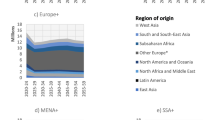Abstract
The population of Western Europe (EC plus EFTA) is seen as consisting of three sub-populations: the natives, the East-European immigrants, and the non-European immigrants. Different immigration levels assumed add to the non-native populations while different levels of “integration” describe the transition intensities from a non-native to a native category. Alternative multi-state population projections to 2050 based on six scenarios show that (1) in the case of no further immigration the total population of Western Europe will start to decline after 2010; (2) the rate of integration influences the future size of the non-European population much more than alternative levels of immigration; (3) in the long run the Eastern Europeans will be quantitatively insignificant; (4) the Western European population is bound to significant population aging no matter what happens with immigration; and (5) in the short to medium run immigrants contribute to the alleviation of the pension burden.
Résumé
La population d'Europe occidentale (CE et AELE) est décomposée en trois sous-populations: les natifs, les immigrants originaires d'Europe de l'Est, et les immigrants originaires du reste du monde. Les populations non-natives augmentent sous l'effet de divers niveaux d'immigration tandis que les intensités de passage d'une catégorie non-native à native sont décrites par différents niveaux d' “intégration”. Des projections de population jusqu'en 2050 dans ces divers états, basées sur six scénarios, montrent que: (1) la population totale de l'Europe occidentale commencerait à baisser après 2010, dans le cas d'un arrêt de l'immigration; (2) le taux d' “intégration” influencerait la taille future de la population non-européenne beaucoup plus fortement que le niveau d'immigration; (3) dans le long terme, les Européens de l'Est serait en nombre très réduit; (4) la population d'Europe occidentale connaîtra un vieillissement important de sa population, quelque soit ses flux d'immigrants; et (5) dans le court et le moyen terme les immigrants contribueraient à alléger le poids des retraites.
Similar content being viewed by others
References
Duchene, J. and Wunsch, G., 1991. Population aging and the limits to human life. In: W. Lutz, ed.Future Demographic Trends in Europe and North America: What Can We Assume Today? Academic, London: 27–40.
Heilig, G., Büttner, T. and Lutz, W., 1990. Germany's population: turbulent past, uncertain future.Population Bulletin 45(4): 1–47.
Lutz, W., ed., 1991.Future Demographic Trends in Europe and North America: What Can We Assume Today? Academic, London.
Lutz, W., Prinz, C., Wils, A.B., Büttner, T. and Heilig, G., 1991. Alternative demographic scenarios for Europe and North America. In: W. Lutz, ed.Future Demographic Trends in Europe and North America: What Can We Assume Today? Academic, London: 523–560.
Manton, K.G., 1991. New biotechnologies and the limits to life expectancy. In: W. Lutz, ed.Future Demographic Trends in Europe and North America: What Can We Assume Today? Academic, London: 97–115.
Steinmann, G., 1991. Immigration as a remedy for the birth dearth: the case of West Germany. In: W. Lutz, ed.Future Demographic Trends in Europe and North America: What Can We Assume Today? Academic, London: 337–357.
Wils, A.B., 1991. Survey of immigration trends and assumptions about future migration. In: W. Lutz, ed.Future Demographic Trends in Europe and North America: What Can We Assume Today? Academic, London: 281–299.
Author information
Authors and Affiliations
Rights and permissions
About this article
Cite this article
Lutz, W., Prinz, C. What difference do alternative immigration and integration levels make to Western Europe?. Eur J Population 8, 341–361 (1992). https://doi.org/10.1007/BF01796626
Received:
Revised:
Issue Date:
DOI: https://doi.org/10.1007/BF01796626




